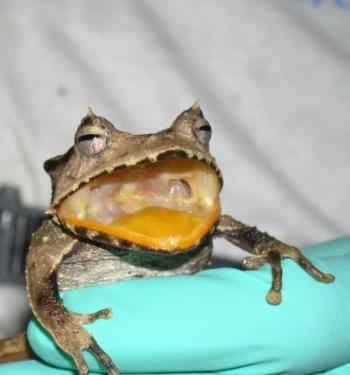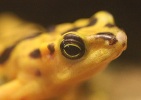With advanced genetic techniques, researchers have drawn a picture of just how devastating the currently extinction crisis for the world’s amphibians has become in a new study published in the Proceedings of the Nation Academy of Sciences (PNAS). Studying frog populations using DNA barcoding in Panama’s Omar Torrijos National Park located in El Copé researchers found that 25 known species and 5 unknown species have vanished since 1998. None have returned.
Amphibians are threatened in many parts of the world by pollution, habitat loss, invasive species, over-exploitation, pesticides, and climate change, yet the big killer of the world’s amphibians is disease: chytridiomycosis, a fungal disease, is wiping out frogs even in the world’s most untouched habitats.
To determine just how devastating chytridiomycosis has become, researchers with the Smithsonian Tropical Research Institute (STRI) looked at the well-surveyed Omar Torrijos National Park in Panama. Surveys had discovered 63 species of frogs in the park prior to the disease’s arrival. Using DNA barcoding, however, researchers were able to identify 11 species that had been unknown to science, bringing the total to 74 species. Five of the unknown species had also vanished due to the disease.
 The Panamanian marsupial frog, Hemiphractus fasciatus, is being tested for the amphibian-killer, chytridiomycosis. Image courtesy of Andrew J. Crawford. |
“It’s sadly ironic that we are discovering new species nearly as fast as we are losing them,” said Andrew Crawford, former postdoctoral fellow at STRI and member of the Círculo Herpetológico de Panamá, in a press release. “Our DNA barcode data reveal new species even at this relatively well-studied site, yet the field sampling shows that many of these species new to science are already gone here.”
According to the paper, since arriving the disease has wiped out over 40 percent of the park’s total amphibian species, and one-third of the amphibians’ evolutionary history.
“It’s like the extinction of the dinosaurs. The areas where the disease has passed through are like graveyards; there’s a void to be filled and we don’t know what will happen as a result,” says Karen Lips, associate professor at the University of Maryland and co-author. Lips established the first amphibian monitoring programs in the area after the crisis was discovered.
While DNA barcoding, which uses short genetic markers to quickly identify species, is not without its critics who call it unreliable in certain circumstances, it has become an increasingly popular tool for biological studies and conservation work.
“This is the first time that we’ve used genetic barcodes—DNA sequences unique to a given species—to characterize an entire amphibian community,” says Eldredge Bermingham, STRI director and co-author. “STRI has also done barcoding on this scale for tropical trees on in our forest dynamics-monitoring plot in Panama. The before-and-after approach we took with the frogs tells us exactly what was lost to this deadly disease—33 percent of their evolutionary history.”
According to the IUCN Red List, 30 percent of the world’ amphibians are threatened with extinction. Researchers say that in the very least 120 species of amphibians have vanished in the last three decades.
CITATION: Andrew J. Crawford, Karen R. Lips, and Eldredge Bermingham. Epidemic disease decimates amphibian abundance, species diversity, and evolutionary history in the highlands of central Panama. PNAS.
Related articles
Two new frogs discovered in Panama amidst amphibian plague

(06/06/2010) Researchers working to save Panama’s frogs from a fatal disease have stumbled on two species unknown to science. In Omar Torrijos National Park they found a bigger version of a common species, which is now known to be a unique species, and near the Colombian border they discovered a new frog that has been named after Spanish for DNA. Both frogs were discovered while researchers searched for frog populations in chytridiomycosis-infected areas. The highly contagious disease chytridiomycosis has devastated frog species worldwide and is believe to be at least in part responsible for some 100 extinctions of amphibians.
Gone: a look at extinction over the past decade

(01/03/2010) No one can say with any certainty how many species went extinct from 2000-2009. Because no one knows if the world’s species number 3 million or 30 million, it is impossible to guess how many known species—let alone unknown—may have vanished recently. Species in tropical forests and the world’s oceans are notoriously under-surveyed leaving gaping holes where species can vanish taking all of their secrets—even knowledge of their existence—with them.
Scientists uncover mystery of how frog plague kills its victims
(10/22/2009) One hundred and twenty species of frogs are reported to have gone extinct since 1980 (although the number is likely even higher). While devastated by habitat loss, pollution, and climate change, a baffling disease may be the biggest factor behind the alarming extinctions of frogs. Called chytridiomycosis, the disease is caused by the microscopic fungus Batrachochytrium dendrobatidis which kills its tiny victims indiscriminately.